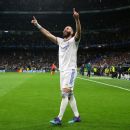Real Madrid without Casemiro: Ancelotti has a plan for his LaLiga-winning midfield
Casemiro #Casemiro

Want to know how important Casemiro was to Real Madrid? Ask Luka Modric and Toni Kroos. Two-thirds of the most iconic midfield trio in modern football — with apologies to Barcelona’s Sergio Busquets, Xavi and Andres Iniesta — are now facing up to life without the man Modric called “the best bodyguard in the world.”
When reports of Manchester United’s interest first surfaced, Kroos couldn’t wait: he texted Casemiro at 4 a.m., asking if it was true. He later posted eight photos on Instagram, all of Casemiro, Kroos and Modric posing with a different trophy. His caption: “You won’t find a lost final in this combination. Says it all! Gonna miss it. Gonna miss you.”
Casemiro — a player who landed in Madrid in January of 2013 as an unheralded and unknown midfielder originally slated to play for reserve team Castilla — leaves one of the most decorated players in the game and, at €70m, the second-most expensive footballer over the age of 30. Only one player — Madrid’s Paco Gento — has won more European Cups.
The Brazilian will be missed at the Bernabeu now he has moved to United, but a look at Real Madrid’s squad and performances over the past year suggests the ingredients are there to compensate for his loss.
– Stream on ESPN+: LaLiga, Bundesliga, MLS, more (U.S.)
An indispensable figure for so long
It was seven years ago, in the 2015-16 season, that Casemiro set about making himself indispensable to Real Madrid’s midfield. There was competition for places that year, with Casemiro, Kroos and Modric joined by James Rodriguez, Isco and Mateo Kovacic in a packed squad, but it soon became apparent — notably with his absence in the 4-0 home defeat to Barcelona in November 2015 — that only the Brazilian’s inclusion brought balance to the team.
– Dawson: Why Man United signed Casemiro- Transfer grades: United get an A- Everything you need to know about Casemiro
Under manager Zinedine Zidane, the Casemiro/Kroos/Modric triumvirate became untouchable, coinciding with Madrid’s record-breaking run of three consecutive Champions League wins. Their 2016-17 season was his most eye-catching — scoring spectacular goals against Napoli and in the final against Juventus — while 2020-21 might have been his most influential, even finishing as the team’s second-highest scorer (7) behind Karim Benzema (30.)
Last year Casemiro’s form was more inconsistent, but he still made 230 ball recoveries in LaLiga, almost as many as Kroos (125) and Modric (123) combined. It was after ending the season on a high, with a LaLiga and Champions League double, that Casemiro first thought about leaving.
“I felt like a cycle had ended,” he said on Monday. “It was mission accomplished.”
Real Madrid still have two-thirds of the midfield that has been dominant in Spain and Europe despite Casemiro’s exit. Victor Carretero/Real Madrid via Getty Images The timing was right to refresh
Fortunately for Real Madrid, a succession plan was already in place. In fact, it was that plan — signing Aurelien Tchouameni from Monaco for €80m in June — that helped convince Casemiro to move on.
Casemiro, still six years younger than Modric, wasn’t best pleased that a ready-made replacement had been identified and recruited so soon. He had to be placated during the club’s preseason tour of the United States, with manager — or chief diplomat — Carlo Ancelotti reassuring him that he was still first choice. Yet the doubts had already set in, and his mind couldn’t be changed.

2dChris Wright

2dAlex Kirkland and Rodrigo Faez

11dESPN
2 Related
In truth, it wasn’t bad timing from the club’s point of view. Real Madrid have always been shrewd judges of when to unload players, and their record in signing them isn’t bad either; with Tchouameni on board, the club is not expected to move again in the transfer market to cover the loss of Casemiro. In all, six midfielders will be tasked with taking the team forward: Kroos, Modric and Tchouameni, plus Eduardo Camavinga, Federico Valverde and Dani Ceballos.
“We have a lot of good players who can play in [Casemiro’s] position,” Ancelotti said last week. “Tchouameni is one of the best midfielders in the market right now. There’s the option of Toni, who can play there as he did in my second year here [2014-15] … and we have [Eduardo] Camavinga.
“Defensively, Tchouameni is the player who’s most like Casemiro. But Kroos can play there, if you take into account who plays alongside him.”
Aurelien Tchouameni, right, feels like the most natural player to slot into Casemiro’s position, but it seems as though Carlo Ancelotti, left, will adopt a committee approach depending on the opponent. David S. Bustamante/Soccrates/Getty Images Tchouameni or Camavinga?
As job interviews go, Tchouameni’s performance in the first game of the post-Casemiro era — Madrid’s 4-1 win away at Celta Vigo last Saturday — was convincing. The 22-year-old had more touches (87) than any Real Madrid player, and only Valverde could match him for ball recoveries (9). He created three chances too.
The role Tchouameni played in Madrid’s third and fourth goals was notable, starting both moves with decisive interventions in his own half, though Ancelotti wasn’t getting carried away. “He has to learn,” the manager said. “He has to position himself better. But he’s convincing in duels and in the air, he has good feet, and he gets into the box.”
The idea floated by Ancelotti that Kroos could retreat into a more withdrawn role is less convincing. The German has never looked comfortable as a lone holding midfielder. If anything, the key to Casemiro’s success was to relish the midfield “dirty work” and allow Kroos to focus on what he does best: setting the tempo with the accuracy of his short- and long-range passing.
Camavinga is yet to convince in the role. It’s notable that in four of last season’s 13 LaLiga starts he was substituted at half-time, while his most memorable contributions in the Champions League came off the bench. For now, he looks best suited to a midfield role that allows more freedom and requires less positional discipline.
One solution might be looking to replicate some of Casemiro’s qualities elsewhere on the pitch, rather than attempting to replace him like-for-like. Valverde has developed into nobody’s idea of a holding midfielder, finding a role over the past year as a marauding, tireless right-sided midfield/wing hybrid, but the 24-year-old can match Casemiro for uncompromising attitude and mentality. The two were close friends, boasting a kinship built on shared experience, humility and a lack of ego: two industrious overachievers who had to force their way from Castilla to the first team.
When the names of Tchouameni and Camavinga were put to Casemiro in his farewell news conference as representing the future, he was quick to add Valverde to the list. “Madrid have a player there for 10 or 12 years, easily,” he said.
The future?
Real Madrid’s prospects depend on how well Ancelotti can blend the two surviving members, Kroos and Modric, of what the coach called his “Bermuda Triangle” midfield — “the ball gets lost in there” — with the “rock ‘n’ roll” generation of Tchouameni, Camavinga and Valverde.
The next test comes on Sunday away at Espanyol, before a first home game of the season against Real Betis, with a bigger test coming against Atletico Madrid on Sept. 18.
In the end, successfully replacing Casemiro might come down to what three players — Tchouameni in the same position, Camavinga off the bench and Valverde on the right — can collectively contribute.